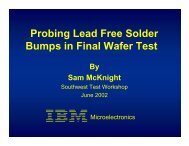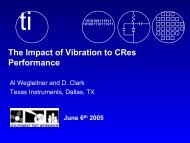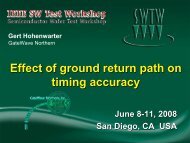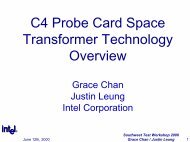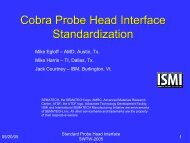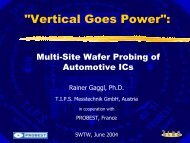Probe Card Cleaning Media Survey - Semiconductor Wafer Test ...
Probe Card Cleaning Media Survey - Semiconductor Wafer Test ...
Probe Card Cleaning Media Survey - Semiconductor Wafer Test ...
Create successful ePaper yourself
Turn your PDF publications into a flip-book with our unique Google optimized e-Paper software.
<strong>Probe</strong> <strong>Card</strong><br />
<strong>Cleaning</strong> <strong>Media</strong> <strong>Survey</strong><br />
Eric Hill, Josh Smith : : June 10, 2008
Special Thanks To:<br />
June 10, 2008<br />
IEEE SW <strong>Test</strong> Workshop 2
Outline<br />
Introduction<br />
Materials and Methods<br />
Results<br />
Conclusions<br />
Acknowledgments<br />
June 10, 2008<br />
IEEE SW <strong>Test</strong> Workshop 3
Why Optimize Online <strong>Cleaning</strong>?<br />
Probing is a dirty business<br />
<strong>Cleaning</strong> probe tips keeps device yield up<br />
• Yield is money<br />
Time spent cleaning is lost test cell utilization<br />
• <strong>Test</strong> cell utilization is money<br />
Abrasive cleaning wears out probes<br />
• Replacing probe cards costs money<br />
Optimizing cleaning saves money!<br />
June 10, 2008<br />
IEEE SW <strong>Test</strong> Workshop 4
SWTW-2007 <strong>Cleaning</strong> Tutorial Session<br />
Broz, et. al., SWTW-2007<br />
June 10, 2008<br />
IEEE SW <strong>Test</strong> Workshop 5
<strong>Cleaning</strong> <strong>Media</strong> <strong>Survey</strong><br />
Wide variety of media available<br />
Previous surveys not targeted at Pyramid <strong>Probe</strong>s<br />
Define consistent evaluation criteria<br />
• Mechanical criteria in Phase 1<br />
• Resistance testing in Phase 2<br />
<strong>Test</strong> commercially available abrasive media<br />
• 20 media<br />
• 4 suppliers<br />
• Rigid substrates and unfilled elastomers<br />
not considered<br />
Evaluate and rate media suitability for<br />
use with Pyramid <strong>Probe</strong>s<br />
Search for the “ideal” medium<br />
June 10, 2008<br />
IEEE SW <strong>Test</strong> Workshop 6
What is the “Ideal” <strong>Cleaning</strong> Medium?<br />
Removes adherent contamination from tips<br />
Non existent Tip Wear<br />
No particles generated by cleaning media<br />
No residue left on tips<br />
<strong>Media</strong> captures particles from membrane<br />
<strong>Cleaning</strong> action insensitive to overdrive<br />
R. Marcelis, SWTW-2007<br />
June 10, 2008<br />
IEEE SW <strong>Test</strong> Workshop 7
Measurement Summary (per cleaning medium)<br />
Measure Insertion/Extraction force<br />
Accelerated Wear <strong>Test</strong><br />
http://www.accretech.com<br />
SEM inspection<br />
June 10, 2008<br />
http://www.fei.com<br />
IEEE SW <strong>Test</strong> Workshop 8
Insertion/Extraction Force<br />
2<br />
Insertion Force<br />
Measurement Setup<br />
Force (g)<br />
1.5<br />
1<br />
0.5<br />
0<br />
0 10 20 30 40 50 60<br />
Displacement (um)<br />
Typical insertion/extraction Curve<br />
June 10, 2008<br />
IEEE SW <strong>Test</strong> Workshop 9
Accelerated Wear <strong>Test</strong><br />
New Pyramid <strong>Probe</strong> card<br />
<strong>Cleaning</strong> touchdowns only<br />
• Vertical motion only<br />
• 100 microns cleaning overdrive<br />
• 50 micron step between touchdowns<br />
• No wafer touchdowns<br />
Touchdown intervals of:<br />
• 1k, 2k, 5k, 10k, 20k, 20k touchdowns (58k total)<br />
After each interval:<br />
• Measure Tip Height<br />
• Optical inspection<br />
SEM inspection after 58k touchdowns<br />
• Assess contamination<br />
http://www.engin.umich.edu/<br />
June 10, 2008<br />
IEEE SW <strong>Test</strong> Workshop 10
Pyramid <strong>Probe</strong> <strong>Card</strong> at a Glance<br />
New probe card used for each medium’s<br />
Accelerated Wear <strong>Test</strong><br />
June 10, 2008<br />
IEEE SW <strong>Test</strong> Workshop 11
Tip Height Measurement<br />
Stylus profilometer<br />
3D scan of region around tip<br />
• 5 scans per tip<br />
• 6 micron spacing between<br />
scans<br />
Record Total Indicated Runout<br />
(TIR) relative to local<br />
membrane surface<br />
Measurement accuracy of<br />
0.5 microns or better<br />
Repeated for each tip<br />
Leveled<br />
surface<br />
Maximum<br />
height<br />
value<br />
June 10, 2008<br />
IEEE SW <strong>Test</strong> Workshop 12
Quantifying contamination generated by<br />
cleaning process (C(<br />
debris )<br />
Image tips after testing in SEM<br />
Qualitatively rank contamination<br />
• 1 = least, 10 = most<br />
• R particle<br />
= relative size of particles (1-10)<br />
• F memb<br />
= frequency of debris on membrane (1-10)<br />
• F tip<br />
= frequency of residue on tip (1-10)<br />
Weighted Debris Function<br />
C debris = [ 0.7 (R particle ) + 0.2 (F memb ) + 0.1 (F tip )]<br />
1 10<br />
June 10, 2008<br />
IEEE SW <strong>Test</strong> Workshop 13
Full Results Summary<br />
Manufacturer Product Type C debris<br />
Single Tip<br />
Spring<br />
Rate (g/µm)<br />
Wear<br />
Rate<br />
(nm/1k TDs)<br />
Allied High Tech Products 1 micron Type B Lapping Film 10.0 1.09 305 Damaged Tips<br />
Allied High Tech Products 6 micron Type B Lapping Film 10.0 1.47 299 Damaged Tips<br />
Allied High Tech Products 3 micron Type B Lapping Film 10.0 1.45 128 Damaged Tips<br />
MIPOX GC6000-PF3 Soft-backed Lapping Film 6.0 0.21 66.5 Uneven Wear<br />
ITS <strong>Probe</strong> Lap 5084 Lapping Film 4.9 1.23 54.6<br />
3M 3M T-CL Soft-backed Lapping Film 5.6 0.79 39.8 Uneven Wear<br />
Allied High Tech Products 3 micron, acetone wash Lapping Film 3.3 2.03 34.2<br />
Allied High Tech Products 3 micron Lapping Film 6.9 2.16 29.9<br />
MIPOX WA8000-SWE Abrasive Coated Foam 3.6 0.19 28.8<br />
MIPOX WA6000-SWE Abrasive Coated Foam 2.7 0.30 23.6<br />
3M 266X – 1 micron Lapping Film 3.7 2.79 15.5<br />
Allied High Tech Products 6 micron Lapping Film 10.0 2.26 14.9 Extreme Debris<br />
MIPOX GC8000-PF3 Soft-backed Lapping Film 7.3 0.14 14.3<br />
3M 265X – 1 micron Lapping Film 3.7 1.21 11.7<br />
MIPOX 1 micron Lapping Film 6.9 2.27 2.6<br />
ITS <strong>Probe</strong> Polish 150 Abrasive Loaded Elastomer 1.0 0.04 2.6<br />
ITS <strong>Probe</strong> Polish 70 Abrasive Loaded Elastomer 2.8 0.01 1.5<br />
MIPOX Si10000-PF3 Soft-backed Lapping Film 7.1 0.03 1.3<br />
ITS <strong>Probe</strong> Polish 99/I Abrasive Loaded Elastomer 1.0 0.01 0.6<br />
MIPOX Si10000-SWE Abrasive Coated Foam 2.8 0.18 0.5<br />
Note<br />
June 10, 2008<br />
IEEE SW <strong>Test</strong> Workshop 14
Accelerated Wear Results Graph<br />
1000<br />
Average Tip Wear (nm/1000TDs)<br />
100<br />
10<br />
1<br />
0.1<br />
0 2 4 6 8 10<br />
C debris<br />
June 10, 2008<br />
IEEE SW <strong>Test</strong> Workshop 15
Accelerated Wear Results Graph<br />
1000<br />
Average Tip Wear (nm/1000TDs)<br />
100<br />
10<br />
1<br />
MORE LESS<br />
ABRASIVE ABRASIVE<br />
0.1<br />
0 2 4 6 8 10<br />
C debris<br />
June 10, 2008<br />
IEEE SW <strong>Test</strong> Workshop 16
Accelerated Wear Results Graph<br />
1000<br />
Average Tip Wear (nm/1000TDs)<br />
100<br />
10<br />
1<br />
LESS CONTAMINATION<br />
0.1<br />
0 2 4 6 8 10<br />
C debris<br />
June 10, 2008<br />
IEEE SW <strong>Test</strong> Workshop 17
Accelerated Wear Results Graph<br />
1000<br />
Average Tip Wear (nm/1000TDs)<br />
100<br />
10<br />
1<br />
C debris = 1<br />
C debris = 3.7<br />
C debris = 6.9<br />
C debris = 10<br />
0.1<br />
0 2 4 6 8 10<br />
C debris<br />
June 10, 2008<br />
IEEE SW <strong>Test</strong> Workshop 18
Accelerated Wear Results Graph<br />
1000<br />
Average Tip Wear (nm/1000TDs)<br />
100<br />
10<br />
1<br />
Preferred<br />
Region<br />
0.1<br />
0 2 4 6 8 10<br />
C debris<br />
June 10, 2008<br />
IEEE SW <strong>Test</strong> Workshop 19
Accelerated Wear Results Graph<br />
Average Tip Wear (nm/1000TDs)<br />
1000<br />
100<br />
10<br />
1<br />
0.1<br />
0 2 4 6 8 10<br />
C debris<br />
Allied 3um<br />
Allied 6um<br />
Allied 1um<br />
Allied 3um (Treated)<br />
Allied 3um Type B<br />
Allied 6um Type B<br />
Allied 1um Type B<br />
ITS PP99/I<br />
ITS PP70<br />
ITS PL-5084 1um<br />
ITS PP150<br />
MIPOX GC6000-PF3<br />
MIPOX GC8000-PF3<br />
MIPOX Si10000-PF3<br />
MIPOX Si10000SWE<br />
MIPOX WA6000SWE<br />
MIPOX WA8000SWE<br />
3M 266X<br />
3M 265X<br />
3M T-CL<br />
June 10, 2008<br />
IEEE SW <strong>Test</strong> Workshop 20
Wear Results Summary<br />
Generally Speaking:<br />
Apparent relationship between tip wear and particle generation<br />
Data from similar media type grouped together<br />
Lapping Films<br />
Soft-Backed Lapping Films<br />
Filled Elastomers<br />
Abrasive Coated Foams<br />
So, how did each<br />
media type perform?<br />
June 10, 2008<br />
IEEE SW <strong>Test</strong> Workshop 21
Lapping Films<br />
Relatively high stiffness<br />
(1-3 g/um)<br />
• Low tip penetration into media<br />
• Particles not captured<br />
Even tip wear over probe tips<br />
Abrasion rate is:<br />
• Related to grit size, grit density,<br />
and grit exposure<br />
• Apparently not related to abrasive<br />
material<br />
• Insensitive to cleaning overdrive<br />
Wide range of particle generation<br />
Generally suitable for all<br />
applications<br />
Tip Wear vs. Position at 58k TDs:<br />
even wear < 2um<br />
June 10, 2008<br />
IEEE SW <strong>Test</strong> Workshop 22
Exception: Lapping Films with Ceramic Sphere<br />
Encased Abrasive<br />
Not suitable for Pyramid <strong>Probe</strong> card cleaning!<br />
Spherical<br />
indentations<br />
Courtesy of Allied High Tech<br />
Products, Inc.<br />
Ceramic and<br />
diamond particles<br />
June 10, 2008<br />
IEEE SW <strong>Test</strong> Workshop 23
Soft-Backed Lapping Films<br />
Low to Medium stiffness<br />
(0.03- 0.8 g/um)<br />
• Moderate tip penetration into<br />
media<br />
Uneven tip wear<br />
• Hard Abrasives wear tips<br />
unevenly<br />
• Soft (SiO 2<br />
) abrasive OK, but<br />
probing generates lots of debris<br />
Not Recommended for use with<br />
Pyramid <strong>Probe</strong> cards<br />
Tip Wear vs. Position at 58k TDs:<br />
even wear > 8um<br />
June 10, 2008<br />
IEEE SW <strong>Test</strong> Workshop 24
Soft-Backed Lapping Films:<br />
Corner-Edge Wear Mechanism<br />
(Membrane <strong>Probe</strong>s)<br />
Two relatively stiff films, supported by soft layers<br />
Force is concentrated on end and corners of pattern<br />
June 10, 2008<br />
IEEE SW <strong>Test</strong> Workshop 25
Soft-Backed Lapping Films:<br />
Corner-Edge Wear Mechanism<br />
(Membrane <strong>Probe</strong>s)<br />
Two relatively stiff films, supported by soft layers<br />
Force is concentrated on end and corners of pattern<br />
June 10, 2008<br />
IEEE SW <strong>Test</strong> Workshop 26
Abrasive Filled Elastomers<br />
Low Stiffness<br />
(0.01 to 0.05 g/um)<br />
• High tip penetration into media<br />
• Most of the overdrive applied deforms<br />
the media<br />
• Effective overdrive limited by height of<br />
tip<br />
• Membrane always contacts media<br />
Very low tip wear<br />
Slight tip radiusing<br />
• More apparent with higher abrasive<br />
loading<br />
Safe for all uses<br />
Best for long probe tip life<br />
New Tip<br />
After 58k TDs<br />
June 10, 2008<br />
IEEE SW <strong>Test</strong> Workshop 27
Abrasive Coated Foams<br />
Medium Stiffness<br />
(0.18 to 0.3 g/um)<br />
• Spring rate less consistent point-to-point<br />
than other media types<br />
• Moderate tip penetration into media<br />
• Edges of membrane contact media<br />
Even tip wear<br />
Low particle generation<br />
Radiuses tips<br />
Courtesy of MIPOX International<br />
June 10, 2008<br />
IEEE SW <strong>Test</strong> Workshop 28
Coated Foams Radiuses Tips<br />
New Tips<br />
58kTDs on WA8000-SWE<br />
Consistent with product documentation, previous results (Broz et. al., SWTW-<br />
2007)<br />
May not be suitable for POAA and low-k dielectric probing<br />
• Decreased contact area creates increased pressure<br />
• Qualification at end-of-life required<br />
Special application opportunity for parametric (scribeline) probing<br />
June 10, 2008<br />
IEEE SW <strong>Test</strong> Workshop 29
<strong>Media</strong> Type Summary<br />
<strong>Media</strong> type has profound difference on particle<br />
generation and wear rate, which are predominantly<br />
affected by:<br />
• <strong>Media</strong> stiffness<br />
• Abrasive grit size<br />
• Abrasive spacing<br />
• Abrasive Hardness?<br />
June 10, 2008<br />
IEEE SW <strong>Test</strong> Workshop 30
Does Abrasive Hardness matter?<br />
Yes, but only when it is less than the tip hardness.<br />
Fused silica abrasive doesn’t wear out Pyramid <strong>Probe</strong> tips<br />
Possible avenue to create an “ideal” medium<br />
June 10, 2008<br />
IEEE SW <strong>Test</strong> Workshop 31
Phase 1 Results<br />
<strong>Media</strong> can be grouped into four classes<br />
• Each class has unique properties, allowing for recipe customization<br />
• Groupings consistent with those in <strong>Probe</strong> <strong>Card</strong> <strong>Cleaning</strong>, “A Short<br />
Tutorial”, Broz, et al. SWTW-2007<br />
Wide variety of media properties<br />
http://www.homemadesimple.com<br />
June 10, 2008<br />
IEEE SW <strong>Test</strong> Workshop 32
Phase 1 Conclusions<br />
Phase 1 shows which media are safe for Pyramid <strong>Probe</strong>s<br />
• 11 media newly recommended<br />
• One class of media to avoid (soft-backed lapping films)<br />
Phase 1 survey provides a toolset for optimizing media to<br />
contaminant<br />
1. Maintain yield while reducing tip wear by 30X<br />
2. Improve yield by increasing effectiveness of cleaning<br />
3. Extend interval between cleaning touchdowns<br />
We assume that media actually clean probe tips, which is not<br />
supported by data– yet.<br />
June 10, 2008<br />
IEEE SW <strong>Test</strong> Workshop 33
Next Steps: Phase 2 <strong>Survey</strong><br />
Phase 2: Verify cleaning effectiveness with R c measurements<br />
• Focus on solder ball wafers<br />
• Blanket aluminum wafers<br />
• Use safe media found in Phase 1<br />
Apply results to minimize Pyramid <strong>Probe</strong><br />
Cost of Ownership<br />
Work with suppliers to develop “ideal” media<br />
June 10, 2008<br />
IEEE SW <strong>Test</strong> Workshop 34
Acknowledgements/ Thanks<br />
Yoshiko Hayase, MIPOX International<br />
Tetsujiro Tada, MIPOX International<br />
Jerry Broz, Ph.D., International <strong>Test</strong> Solutions<br />
Kim Dermit, Allied High Tech Products, Inc.<br />
Bruce Sventek, 3M Electronics Markets Materials Division<br />
Josh Smith, Cascade Microtech<br />
Vickie Van Syckel, Cascade Microtech<br />
Eric Abel, Ph.D., Cascade Microtech<br />
June 10, 2008<br />
IEEE SW <strong>Test</strong> Workshop 35


